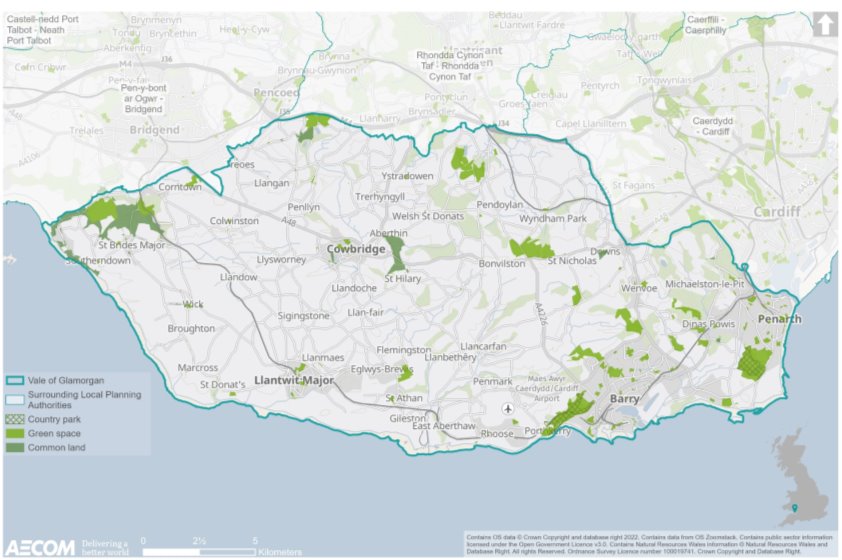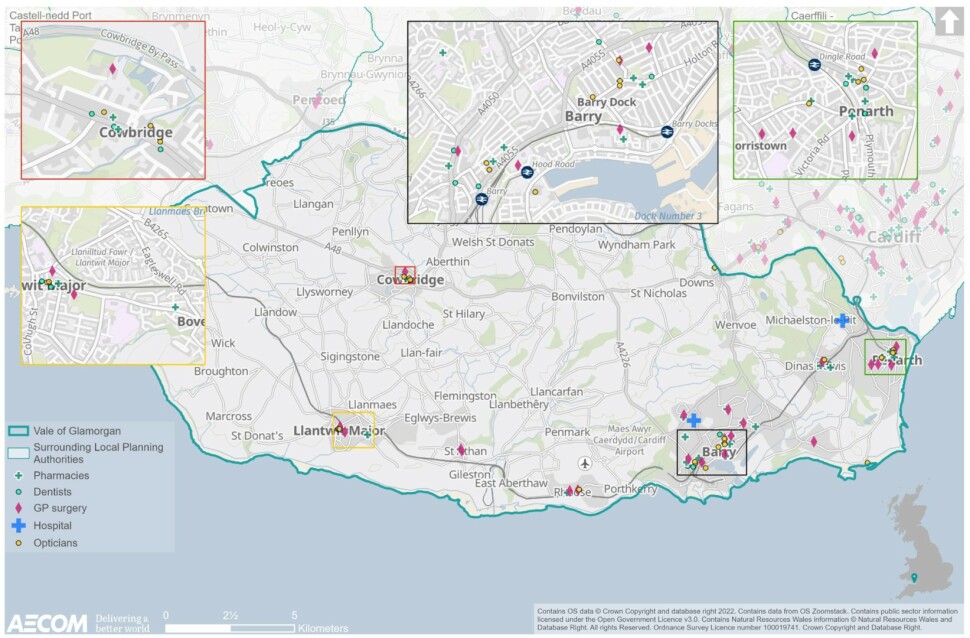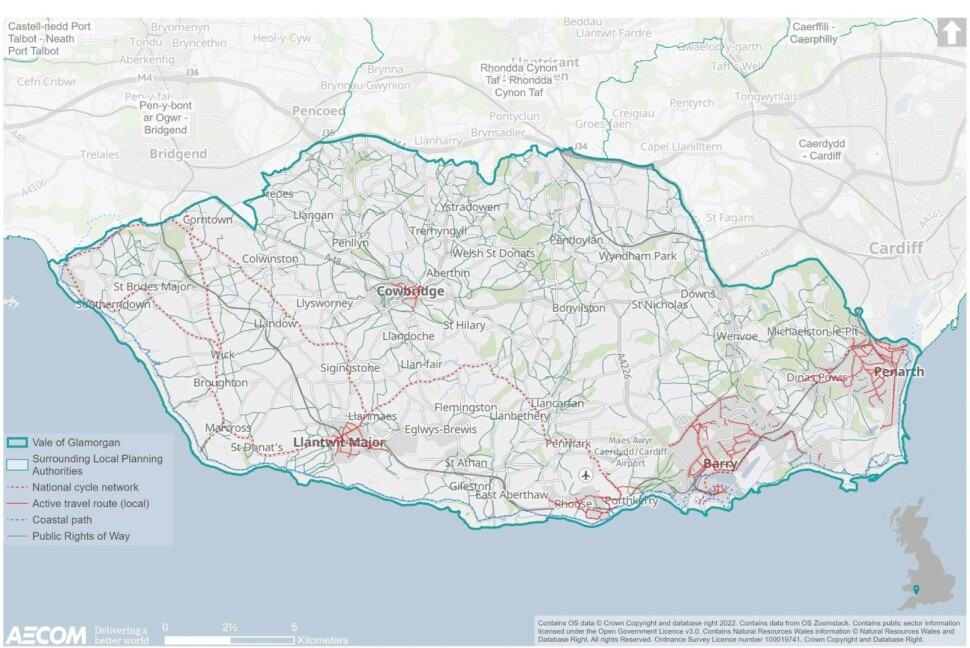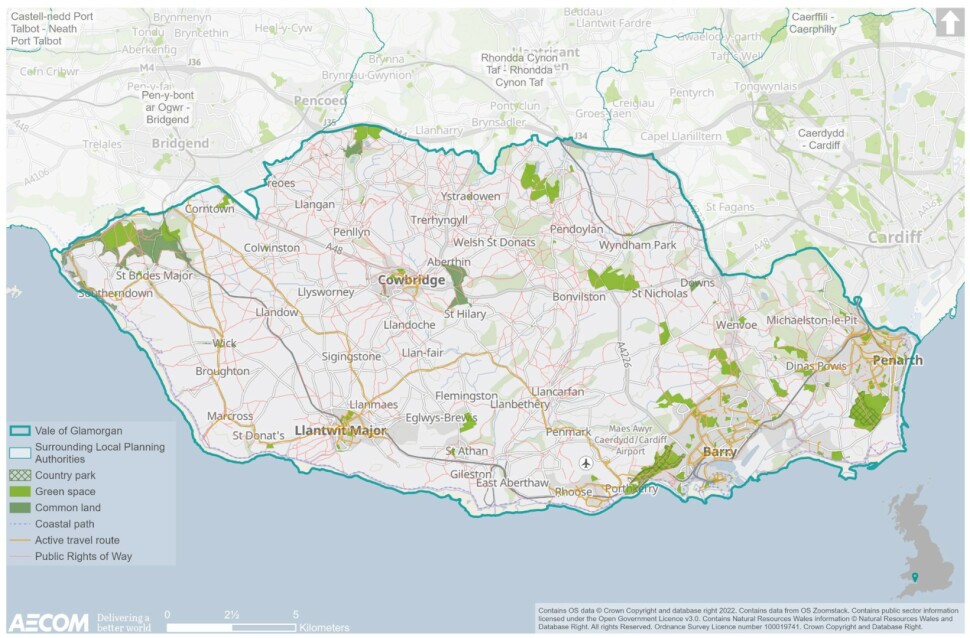Integrated Sustainability Appraisal (ISA) Scoping Report
4. Health and wellbeing
4.1 This theme focuses on the general health of the population in Vale of Glamorgan, as well as access to open space and play facilities, healthcare facilities and active travel. It also refers to public art as it is proven that the arts greatly contribute to people's health and wellbeing both mentally and physically.
Policy context
4.2 Table 4.1 presents the most relevant documents identified in the policy review for the purposes of the RLDP and ISA.
Table 4.1 Policy context
Document title
Year of publication
2015
4.3 Key messages emerging from the review are summarised below:
- Future Wales sets out the 20-year spatial framework for land use in Wales, providing a context for the provision of new infrastructure/ growth. Future Wales identifies Vale of Glamorgan as falling within the South East Wales region, the smallest of the four regions by area, including the coastal cities of Cardiff and Newport and the former industrial heartlands of the south Wales valleys. Future Wales highlights the importance of the region's connections with the Mid Wales and South West regions and the West of England region. Promoting accessibility and inter-linkages (i.e., sustainable transport and employment) across the regions, alongside providing the necessary digital infrastructure, will benefit the physical and mental health of the population. Furthermore, supporting Vale of Glamorgan as an area with essential services and facilities alongside strategic digital and green infrastructure will have a beneficial impact on residents' overall wellbeing.
- The RLDP will be required to be in general conformity with PPW which predominately seeks to ensure planning decisions support all aspects of well-being. PPW places the concept of placemaking at the centre of national planning policy to deliver new development which is sustainable and provides for the needs of all people.
- PPW is supplemented by TANs, which translate Welsh Government's commitment to sustainable development into the planning system and provide national planning policy in respect of health. Notably the RLDP will be required to:
─ Contribute to the protection and, where possible, the improvement of people's health and wellbeing as a core component of achieving the well-being goals and responding to climate change.
─ Consideration of the possible impacts of developments – positive and/or negative – on people's health at an early stage will help to clarify the relevance of health and the extent to which it needs to be considered.
─ Development plan policies should be designed to ensure, as far as is practicable, that noise-sensitive developments, such as hospitals, schools, and housing, that need to be located close to the existing transportation infrastructure to facilitate access, are designed in such a way as to limit noise levels within and around those developments; and
─ Development plan policies and decisions on planning applications should consider national air quality objectives, recognising that they represent a pragmatic threshold above which government considers the health risks associated with air pollution are unacceptable. - World Health Organisation provides guidelines on the health effects of noise and national indicators set by the Welsh Ministers under the Well-being of Future Generations (Wales) Act 2015, together with information from the local authority's annual air quality reports, national noise maps and any area statements issued by Natural Resources Wales under the Environment (Wales) Act 2016.
- The Planning and Enabling Healthy Environments: Incorporating a template for planning policy report promotes a better understanding of the broad environmental and social barriers that impact on health, well-being, and inequality, and sets out guidance on how policies and plans can address these issues.
- The Placemaking Wales Charter builds on the strengthening focus on Placemaking in policy and practice in Wales and aims to provide a common understanding of the range of considerations that go into placemaking. The charter outlines the following six placemaking principles that cover the range of considerations that contribute to establishing and maintaining good places:
─ People and community.
─ Movement.
─ Location.
─ Public realm.
─ Mix of uses; and
─ Identity. - Article 31 of the United Nations Convention on the Rights of the Child[69] states that 'Children have the right to relax and play, and to join in a wide range of cultural, artistic and other recreational activities'. The Cardiff and Vale Director of Public Health Moving Forwards: Move More, More Often report (2018) emphasised the importance of active play to children's physical, mental, social and emotional health and well-being. Having welcoming places, enough time and the company of others to play every day is of great importance to all children and teenagers.
- In March 2021 the Welsh Government announced that active travel schemes will receive a funding boost of more than £53 million as part of the Government's efforts to encourage healthy travel. In addition, pupils will be helped to get to school through the 'Safe Routes in Communities' grant, supporting schemes across Wales. This will contribute towards delivering the priorities identified and agreed through the various health, social care and wellbeing strategies identified in Table 4.1 above.
- In 2020, the Council published its Coronavirus Recovery Strategy[70], which sets out the social, economic and well-being impacts that the pandemic has had on communities and setting out its key priorities. This supports the Vale's Corporate Plan 2020-2025; notably objectives include 'working in partnership to maximise people's physical and mental well-being' and 'understanding how our environment contributes to individual, community and global well-being.'
- Vale of Glamorgan Public Services Board is currently applying for World Health Organisation (WHO) Age Friendly status in the Vale. This status will be recognition that the Vale is a place where people of all ages can live happily and healthily, especially as they grow older. The Cardiff and Vale Director of Public Health 2019 Re-imagining Ageing into the Future report emphasised the key health impacts of the built and natural environment upon older people's health and wellbeing.
Baseline summary
General health
4.4 The following trends have been identified in relation to general health in the Vale of Glamorgan:[71],[72]
- Adults in the Vale of Glamorgan record overall good health when compared to peers from different areas of Wales.
- For both females and males, the Vale of Glamorgan records one of the highest average life expectancies at birth.
- The rate of premature deaths from non-communicable diseases is among the lowest in Wales, while the rate of avoidable mortality is the second lowest in Wales.
- There are clear inequities in health between those living in the least and most deprived areas of the Vale of Glamorgan. Not only are those from more deprived areas expected to live less years, but during their lives are more at risk of experiencing: chronic conditions, limiting long-term illness, mental health conditions and as a result premature death.
- Adults in the Vale of Glamorgan generally record engagement in healthy behaviours above the Welsh national average. However, alcohol consumption above guidelines remains a concern in the Vale of Glamorgan, particularly in the Western Vale.
- There are differences in engagement in healthy behaviour between the least and most deprived areas; with those in most deprived areas less likely to engage in healthy behaviours, and most likely to experience poor health outcomes as a result.
- In terms of wellbeing, slightly more people in the Vale of Glamorgan report being satisfied with where they live than the Welsh national average.
- It is estimated that by 2035 3,311 of the Vale's population aged 65 and over will have dementia.
- The Vale of Glamorgan has the lowest rate of childhood obesity in Wales at 7.1% as recorded by the Childhood Measurement Programme. The highest rates are observed in areas of higher deprivation.
- The Vale of Glamorgan has the highest percentage of adults (16+) drinking above national guidelines in Wales. It is estimated that 25.5% of adults in the Vale drink above national guidelines compared to the national average of 19.1%.
Open space and play facilities
Open space
4.5 Access to open space can have benefits that are both mental and physical. Areas of deficiency may therefore result in a population that does not participate in informal physical activity, alongside other secondary effects associated with environmental inequality. In this regard, the adopted LDP allocates several public open spaces including Barry Waterfront, designated Country Parks, fields, and farmland. The Vale's green spaces are shown in Figure 4.1 below, with Country Parks and Common Land separately identified.
4.6 As shown in Figure 4.1, designated green spaces are relatively sporadic throughout the Vale, with significant areas of Common Land to the east of Cowbridge and within St Brides Major to the northwest of the Vale.
4.7 Figure 4.1 shows the Vale's two Country Parks are significant in size, (Cosmeston Lakes and Porthkerry), located to the southwest of the authority.
4.8 Notably, designated as a Country Park in 1978, Cosmeston Lakes Country Park covers an area more than 100 hectares.[73] The Park provides a range of informal recreation opportunities in close proximity to large numbers of the Vale of Glamorgan population. Centred on two flooded quarries, the country park includes a Site of Special Scientific Interest (SSSI) and provides a wide variety of natural habitats and diverse plant and animal species.
4.9 There are 597 hectares of access land throughout the Vale (where people can walk anywhere, instead of having to keep to linear paths), 91 hectares of this is NRW managed woodland. In total 2% of the Vale of Glamorgan's area is access land.[74]
4.10 Notably, the Vale has good accessibility to the Welsh coast, including the Glamorgan Heritage Coast and the All Wales Coast Path, access to which supports health and wellbeing.
4.11 The arts have numerous benefits which include contributing to people's health and wellbeing both mentally and physically. Public art can add to the quality of the built environment improving where and how people live. Public open space may provide opportunities for the integration of new public art and there are numerous good examples of this in the Vale.
Play facilities
4.12 Having access to recreational play spaces such as parks and playgrounds can improve levels of physical activity amongst children and young people and can reduce the risk of obesity. Play spaces can be both formal and informal, and they should be easy to access.
4.13 The Vale of Glamorgan Play Sufficiency Assessment & Action Plan (2019) highlighted that some children and young people living in rural area struggle to access play opportunities due to issues such as traveling to the opportunity. However, it was also be noted that some children and young people from non-rural areas also had difficulties accessing outdoor play opportunities due to their ability to travel to their desired locations. Highlighting the importance that having access to good transport services can directly affect their wellbeing. The Assessment also highlight that many children in both rural and urban settlements considered the condition of play equipment to be poor.[75]
Food growing
4.14 Having access to a food environment that promotes heathy food choices is an essential component of addressing health issues such as overweight and obesity and long-term chronic conditions. Food growing environments can be private gardens, allotments or food growing spaces outside community buildings.
4.15 It is noted that the Council also run ten allotment sites throughout the Vale. There are eight in Barry and two in the Western Vale.
Healthcare facilities
4.16 As shown in Figure 4.2, there are a total of 28 pharmacies, 21 GP surgeries (13 practices and 8 branch surgeries), 20 dentists and 20 opticians in the Vale. These are concentrated around the main centres of Barry, Cowbridge, Penarth and Llantwit Major.
4.17 Figure 4.2 shows there are also two hospitals present within the Vale of Glamorgan, located in Barry and Llandough.
Figure 4.2 Healthcare facilities
Healthcare facilities:
GP Surgeries
Barry
Cowbridge
Dinas Powys
Llantwit Major
Penarth
Rhoose
St Athan
Sully
Dentists
Barry
Cowbridge
Dinas Powys
Llantwit Major
Penarth
Rhoose
Hospitals
Barry
Llandough (Penarth)
Opticians
Barry
Cowbridge
Culverhouse Cross
Llantwit Major
Penarth
Rhoose
Pharmacies
Barry
Cowbridge
Culverhouse Cross
Dinas Powys
Llantwit Major
Penarth
Rhoose
St Athan
Sully
Active travel
4.18 Active travel means walking and cycling (including the use of mobility scooters) for everyday journeys. This includes journeys to school, to work and to the shops or to access services e.g., health or leisure centres.[76]
4.19 The provision of active travel infrastructure in the Vale of Glamorgan is increasing, and car ownership levels are generally decreasing. However, private car use remains the predominant means of travel in the authority.[77] A reduction in car use and more use of public transport and active travel options (walking and cycling) can improve health and well-being, reduce the negative impacts on the environment that car travel can bring, offer better access to services and facilities, which in turn can offer improved economic opportunities and reduce the potential for traffic accidents.
4.20 The Welsh Government's Active Travel Action Plan for Wales (2016)[78] sets out the vision: "For people in Wales, we want walking and cycling to become the preferred ways of getting around over shorter distances".
4.21 Figure 4.3 below shows the vast extent of walking and cycling routes throughout the Vale. Active travel routes are focussed within the Vale's key settlements, providing communities with sustainable travel options for access to local centres, facilitating day-to-day journeys. There are 544 kilometres of Public Rights of Way (PRoW) extending throughout the Vale, connecting communities and supporting healthy places. It is noted that 61 km of this total is part of the Wales Coast Path, which is notably used for recreation and social reasons as well as travel for everyday journeys.[79]
4.22 As shown in Figure 4.3, with 53 kilometres of coast the Vale of Glamorgan coastline forms an integral part of the Coastal Path stretching from Cardiff Bay/Ely Estuary in the east to the Ogmore River in the west. Recognising the recreational value, since 2007, the Welsh Government has invested in improving public access to the coast of Wales through its Coastal Access Improvement Programme (CAIP).[80] The Wales Coast Path officially opened on May 5th 2012, and the scheme has since continued to improve accessibility for local communities and visitors by improving existing paths and developing new routes. Funded by the Welsh Government and project managed by Natural Resources Wales the programme has delivered a high-quality walking and cycling route around the Welsh coastline.
4.23 Figure 4.3 also shows the National Cycle Network also extending through the west and centre of the Vale, connecting with Barry in the south, through to Penarth (this is discussed further in Chapter 7). This further supports active travel between settlements. Additionally, the Council has installed E Bike stations across the Vale of Glamorgan to encourage active travel use.
4.24 Figure 4.4 below shows green space in relation to active travel routes, indicating accessibility to these spaces via this mode of transport.
4.25 The Vale's sustainable transport infrastructure/ provision is further explored within Chapter 7 of this report.
Figure 4.4 Green space and active travel routes
Future baseline
4.26 Health inequalities exist in the Vale, not only linked to healthy lifestyles but across a wide range of indicators that impact upon an individual's well-being. For example, there are several areas in the more deprived eastern part of Barry where educational attainment is lower, linking to lower levels of employment, there are high levels of overcrowding and there are high numbers of people with long-term health conditions. Access to healthy environments, including green infrastructure and green spaces, is becoming increasingly important, particularly since the onset of the Covid-19 pandemic, which resulted in an increased number of people seeking green spaces for both mental and physical health.
4.27 The RLDP should therefore focus on improving access to green spaces and connectivity to green spaces maintaining and enhancing active travel networks and green infrastructure networks, meeting community infrastructure needs, etc. throughout the Vale. This is likely to support long term improvements in pockets of deprivation where they exist, improving the overall health and wellbeing of residents. Equality of access to facilities, services, green spaces, retail and leisure is crucial to enable people to improve and maintain good health and wellbeing.
4.28 While healthcare assets seem relatively well placed in the plan area, greater accessibility for those most at risk of suffering poor health outcomes should be sought, particularly in the more deprived areas, as discussed in Chapter 5.
Key issues
4.29 The contextual review and baseline information informed the identification of several key issues (problems and opportunities):
- General health of Vale of Glamorgan residents is good. Adults record good health when compared to different areas of Wales, and for both females and males, the Vale of Glamorgan records one of the highest average life expectancies at birth.
- Publicly accessible open space is present throughout the Vale with the greatest provision seen to the southeast, owing to the two large Country Parks present. Although in the urban areas opens space is fragmented and lacks connectivity. Common land and green space are also rich to the northwest of the Vale near St Brides Major.
- The Council's Play Sufficiency Assessment highlight that in rural areas some children and young people experience difficulties accessing play opportunities due to their limited ability to travel to their desired locations, and that many children in both rural and urban settlements considered the condition of play equipment to be poor.
- Active travel networks are good, notably the PRoW network extends throughout the Vale, with local active travel routes focused on the main settlements. This provision connects people and places, delivering health improvements through a modal shift, particularly for shorter journeys. The Council continues to develop an active travel network within the authority through Welsh Government grant and via section s106 monies secured by the Council as part of new developments.
- There is a large provision of healthcare facilities within the Vale of Glamorgan. Health facilities are concentrated around the main centres of Barry, Cowbridge, Penarth and Llantwit Major.
- By 2035, 3,311 of the Vale's population aged 65 and over will have dementia. The LDP will play an important role in addressing this issue, particularly through appropriate housing and facilities for people who fall within this category.
ISA objectives
4.30 Considering the key issues discussed above, it is proposed that the ISA should include the following objective and assessment questions:
ISA objectives
Assessment questions – will the option/proposal help to:
To improve the health and wellbeing of residents within Vale of Glamorgan, promoting healthy and sustainable places.
- Encourage healthy lifestyles and reduce health inequalities through provision of open space, play spaces, food growing, and community spaces?
- Facilitate good access to healthcare, social, recreational and leisure facilities for all sectors of the community?
- Enhance multifunctional green infrastructure networks and connectivity throughout the plan area?
- Provide and enhance the provision of community access to green spaces?
- Improve access to open spaces, the countryside and leisure and recreation facilities?
- Support healthy / active and inclusive environments?
- Support the creation of cohesive, connected communities?
- Provide formal and informal, and natural play spaces for children which are safe and easy and safe to access?
- Reduce health inequalities across the County?
- Support active travel and improvements to air quality?
[69] Unicef (no date): 'The United Nations Convention on the Rights of the Child', [online] available to access via this link
[70] Vale of Glamorgan Council (2020): 'Coronavirus Recovery Strategy', [online] available to access via this link
[71] Vale of Glamorgan Council (2020): 'Corporate Plan '
[72] Vale of Glamorgan PSB (2021): 'Vale of Glamorgan Wellbeing Assessment – Health and Communities Report'
[73] Vale of Glamorgan Council (no date): 'Cosmeston Lakes Country Park and Medieval Village', [online] available to access via this link
[74] Natural Resource Wales (no date): 'Vale of Glamorgan Environment', [online] available to access via this link
[75] Ibid
[76] Vale of Glamorgan Council (date unknown) Home > Living > Active Travel [online] available at: https://www.valeofglamorgan.gov.uk/en/living/transportation/Active-Travel.aspx
[77] Vale of Glamorgan Counci (2021) LDP 3rd Annual Monitoring Report
[78] Welsh Government (2016): 'An Active Travel Action Plan for Wales', [online] available to access via this link
[79] Natural Resource Wales (no date): 'Vale of Glamorgan Environment', [online] available to access via this link
[80] Vale of Glamorgan Council (2016); 'Coastal Access Improvement Programme Background and Update', [online] available to access via this link





